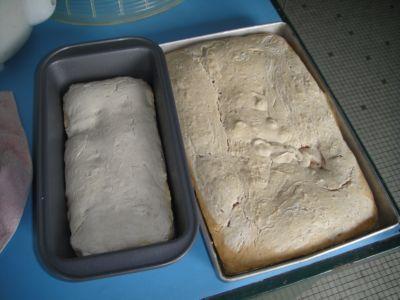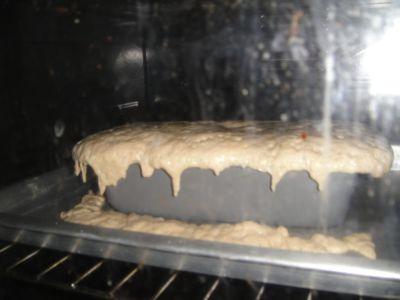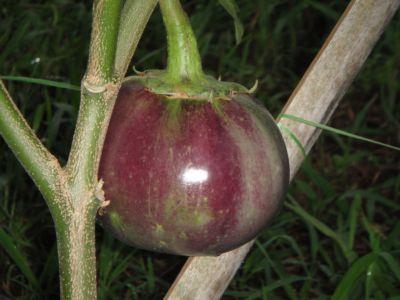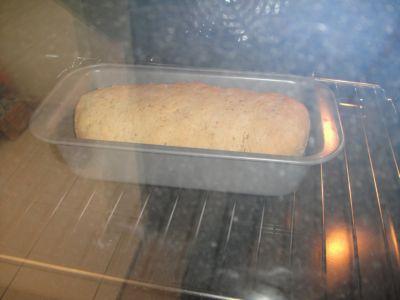This post covers my attempts to make bread without using yeast but with baking soda. I have documented many of the experiments either by date or by experiment number.
1st October 2009
I did experiment making wholemeal bread three or four times last week but the bread did not rise! May be another day I will start with self-raising floor instead of wholemeal flour. I am not using yeast but just baking soda (sodium bicarbonate) and have not tried baking powder…. Just experimenting to see if I can figure out the chemistry of baking bread.
7th October 2009
I tried the whole wheat bread experiment again a few days ago. This time I did two

experiments. The first was just self raising flour with water and a tiny bit of salt and sugar – just to see how it would rise. The second was about two thirds whole wheat floor and one third self-raising flour with a tiny bit of salt and sugar and a lot more water and two teaspoons of baking soda and two teaspoons of baking powder – just to see if the baking powder will make it rise. The bread started rising while I was mixing it so I quickly put it in the oven – both experiments in the oven together.
The first one didn’t rise that much and after a few days was almost rock hard. I ate the second experiment over the next few days. Both had a cake like appearances when I sliced them. But both didn’t have the chewiness of real bread! So today I made a fresh sample of the second experiment without the baking powder and baking soda and will leave it over night for the gluten to be released (?). It’s shouldn’t rise. There is no yeast either. Just want it to become more bread like. This will be experiment #7. The first two or three experiments had to be thrown into the dustbin. Actually in one of the early experiments I added some vinegar into the dough. I thought it would react with the baking soda and cause the bread to rise – it didn’t and was not good to eat so it was thrown away.
12th October 2009: Recipe #7
I must keep the experiments going to understand what is happening. For example

experiment #7 went very wrong. It start to rise as soon as I added the baking powder. It
was easy to rise as there was too much water in the dough. When I put it in the oven it rose very quickly and much of it overflowed onto the lower baking tray and then the rest collapsed! Now I know what too much water can do to the dough. After baking the
bread was bitter. This is, I think, because I left it for 24 hours before I began to prepare it for baking (i mixed in the baking powder after 24 hours) so I threw it away.
Today I was more careful and did experiment #8. That is 2 cups whole wheat flour, 1 cup self-raising flour, 1/2 teaspoon salt & sugar and 3/4 cup water and 1 teaspoon ghee (butter). Left for half an hour before mixing in 2 teaspoons of baking powder. After baking, it was more edible not quite cake like but more like bread but definitely not bread yet. Now I have to think and figure out what should be experiment #9. May be more baking powder, may be more butter, may be less water but then it will be a drier dough instead of a moist dough or may be add more water. I am missing the ‘breadyness’ and the larger holes in my bread.
I know how to make ‘chappati’ which is the unleavened flat bread. I used to make it as a kid and still do every now and then. Its really easy, just mix wholemeal flour with some water and can add a little butter into a dough and leave it aside for a while. Then pinch small balls and flatten it with a rolling pin into circular discs and put it on a hot plate to cook. Once the air pockets form flip the bread over to cook the other side.
I think I am going to drive myself nuts trying to figure out how to make proper wholemeal bread. But it may be worth it!
30th November 2009 : Recipe #10
I tried recipe #10 & #11 to make bread. In recipe #10 I had too much butter and it turned out to be like a short cake or biscuit…He …He …He so now I have solved some of the

problems of making biscuit!!! Bread not solved! In recipe #11 I decided not to use any oil or butter and added more water than before but not as much as the one that overflowed all over the oven. Amazing it actually rose to twice the height! So now I how to make it rise but I still have to get the flavour right. I am now in this delima — SOMEONE PLEASE TEACH ME HOW TO MAKE BREAD and PLEASE DON”T DON’T TELL ME… I WILL GET IT RIGHT SOON! It’s annoying not knowing how to do it right and at the same time I want to experiment and get it right – by experimenting. Don’t teach me, don’t teach me. Recipe #10 went into the dust bin and it dropped like a rock … thud! It fell right through and squashed everything (all the rubbish) that was underneath it. I wonder if I should have called it a ‘Rock Cake’ and tried to sell it to my neighbours. At this rate, one day soon, I am going to have nightmares about baking bread … and that will be the end of my experiments for about a couple of months before I get the courage to restart the bread baking experiments again.
3rd December 2009 : Recipe #13
So I managed to do #13. It was much much better. Getting like bread. I guess the tricks are i) Making the dough very damp almost sticky wet – so easier to rise & ii) let it rest for more than half hour after mixing iii) add the baking powder after the dough has rested so that the chemical reactions won’t release the gasses and rise the dough before it gets into the oven. Recipe #13 tasted more like bread and it had the larger ‘holes’ typical of bread unlike cakes. But it was a little under cooked as I have always been experimenting at 150’C for 45 minutes. The next batch I will try 1 hour or 1.5 hour bake at lower temperature. The crust is very hard but I will try to solve that problem later, let me sort out the bread taste, looks and feel first.
6th December 2009 : Recipe #14
Actually, bread recipe #14 turned out better than I expected and also worse than I expected. Better because it rose and there were large holes and it did almost taste like genuine bread. Worse because I added too much water so the bread took too long to cook and was slightly raw and damp. ….mmmmmm …. guess I have to do experiment #15.
13th December 2009 : Recipe #15
Oh yes I am still experimenting with bread, as it turned out, experiment #15 was a disaster. I think I can use it as a brick! May be I should go into the brick making business … some sort of organic bricks … do you think it would sell? I used less water and more baking powder but it didn’t help. I am sorry I have to tell you about my bread miseries but I guess it would sound very funny later.
Now it has dawned on me that may be I am trying to use the wrong type of flour! … after 15 experiments …. wrong type of flour … what can I say? After the failure of experiment #15 I went to a Japanese supermarket (Jusco, as Tesco & Giant don’t have bread flour) and managed to find a high gluten flour so experiment # 16 will include this floor in the recipe.
17th December 2009 : Recipe #16
I must admit I am a complete failure as a cook. And I am still failing miserably. I think no one will ever employ me as a cook let alone a chef. … There goes my dreams of becoming a world class chef. It’s all gone … my cooking ability. I think if I attend cooking school I will not get an F but probably a Z while everyone else gets A’s for their grades.

Experiment #15 was a disaster as it turned out too hard. … I think it’s still in the dustbin. It didn’t rise and it tasted bitter. I figured out that the bitterness was caused by too much baking powder. I put too much hoping that it will rise quickly before the bread hardens. There is something I am doing very wrong but I have not figured it out yet. If the bread won’t rise properly then it’s either the dough is too hard / stiff or the gas is escaping before the dough can rise. …. Now I know why they let the dough rise before baking it. But if you are not using yeast you can’t let the dough rise before baking. I did get it to rise once before but that was a very watery dough, almost like batter with a lot of baking powder. And that was the first time I noticed that the bread was bitter. If the gases are escaping before the dough can rise than it’s probably because the gluten in the dough has not entangled it’s self enough to trap the gases. The other possibility is that the gases escape while I am kneading the dough. This is the problem when using baking powder; it’s reaction begins the moment it comes in contact with water.
So now you know where I am going to, right? … Experiment #16. I just finished experiment #16 but that was …. another failure? This time around I tried to bake at 120’C instead of 170’C to allow the bread to rise before it hardens or cooks into a permanent shape. After 1 hour and 15 minutes the outside of the bread was soft to touch, just like normal bread and it was easy to cut with a knife, just like normal bread. But the inside was not cooked properly. I guess half an hour at 170’C translates to 16 hours at 120’C (because
chemical reactions double in speed for every 10’C rise in temperature). I could not wait 16 hours so I took it out of the oven after one and half hours. It did rise but not as mush as I was hoping.
Experiments #15 & #16 were done with whole wheat flour instead of plain flour. I think I should simplify the experiments by going back to plain self-raising flour and see what happens. In both experiments I had used Gluten, about 10%. This is because I found a shop selling gluten floor – the proteins in bread dough. So it tasted more like bread than cake.
I think I should try a more watery dough with self-rasing flour and some gluten and see how that goes. … the trials and errors of a failed cook. It’s has become a comedy of errors. Tomorrow I will find a solution! Now I have just boiled two eggs … what can go wrong
with boiling eggs? And will have that with chili sauce and … no bread.
21st December 2009 : Recipe #18
Remember I said “what can go wrong with boiling eggs?”. Well it did go wrong! I didn’t put enough water to cover the eggs and when I cracked the eggs the part that was below the water was hard boiled but the part above the water was soft boiled. I just don’t know what I am doing. I am making too many mistakes. I guess it because I am in a hurry about everything and nothing is happening. So now I have learnt how to boil half an egg hard
and the other half soft!
I tried bread recipe #17 yesterday but I dare not slice it as it appears on the outside as hard as rock. Hence it is lying there on the kitchen table, looking like a rat … it small and squarish, and reminding me about my cooking prowess or rather the lack of it.
Leave a Reply